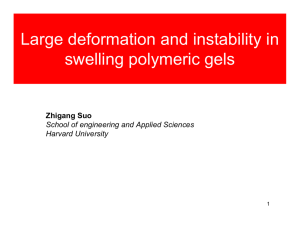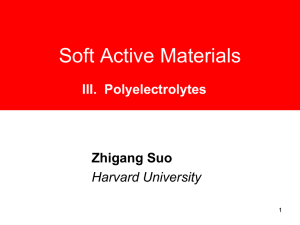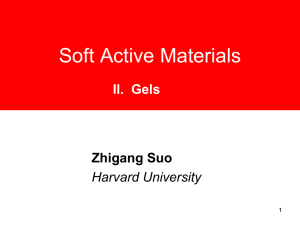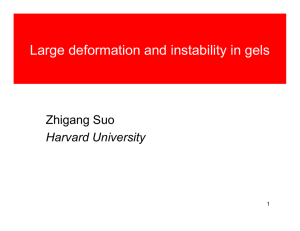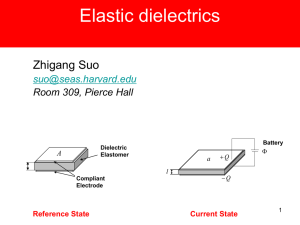Mechanics of Soft Active Materials (SAMs) Zhigang Suo Harvard University
advertisement
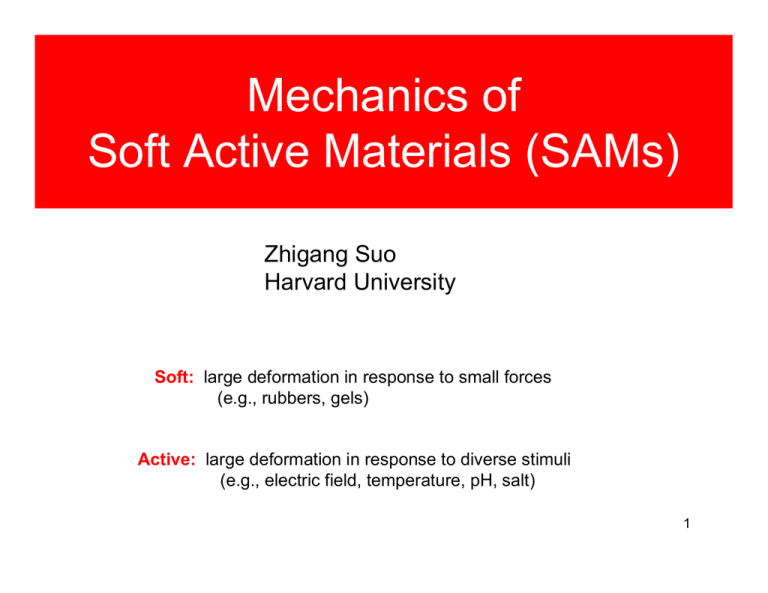
Mechanics of Soft Active Materials (SAMs) Zhigang Suo Harvard University Soft: large deformation in response to small forces (e.g., rubbers, gels) Active: large deformation in response to diverse stimuli (e.g., electric field, temperature, pH, salt) 1 Dielectric elastomer: electrostatics meets mechanics Reference State A Current State Dielectric Elastomer L a l Compliant Electrode Pelrine, Kornbluh, Pei, Joseph High-speed electrically actuated elastomers with strain greater than 100%. Science 287, 836 (2000). +Q Φ −Q 2 Insertion reaction: electrochemistry meets mechanics electron Positive electrode − Load Negative electrode Li-ion + Electrolyte Lithium-ion battery Conducting polymers 3 gel = network + solvent solvent reversible gel network Solid-like: long polymers crosslink by strong bonds. Retain shape Liquid like: polymers and solvent aggregate by weak bonds. Enable transport 4 Valve in microfluidics David Beebe Responsive to Physiological variables: •pH •Salt •Temperature •light 5 Beebe, Moore, Bauer, Yu, Liu, Devadoss, Jo, Nature 404, 588 (2000) Gels regulate flow in plants Missy Holbrook Zwieniecki, Melcher, Holbrook, Hydrogel control of xylem hydraulic resistance in plants Science 291, 1095 (2001) 6 Swelling packers in oil wells 7 A project with Schlumberger Gels as transducers • A swelling gel is blocked by a hard material. • Blocking force. • Inhomogeneous deformation. Need to formulate boundary-value problems 8 2 ways of doing work Reference state Current state M=0 Equilibrium condition AL = Helmholtz free energy per volume λ= δM l L P s= A C= gel P δl δM +µ AL AL δW = sδλ + µδC W (λ , C ) l δF M pump µSolvent, µ L δF = Pδl + µδM A M AL δl P weight 9 Inhomogeneous field Deformation gradient FiK = Concentration Free-energy function C (X ,t ) W (F, C ) ∂x i (X,t ) ∂X K Gibbs (1878) Condition of equilibrium ∫ δWdV = ∫ Biδxi dV + ∫ Tiδxi dA + µ ∫ δCdV µ = constant solvent Gel 1. How to solve boundary-value problems? 2. How to prescribe W (F, C ) ? 3. What boundary-value problems to solve? Weight 10 Hong, Zhao, Zhou, Suo, JMPS 56, 1779 (2008) Finite element method Equilibrium condition ∫ δWdV = ∫ B δx dV + ∫ T δx dA + µ ∫ δCdV Legendre transform ˆ (F, µ ) = W − µC W i i i i ˆ dV = B δx dV + T δx dA δ W ∫ ∫ i i ∫ i i •A gel in equilibrium is analogous to an elastic solid •ABAQUS UMAT 11 Hong, Liu, Suo, Int. J. Solids Structures 46, 3282 (2009) Free-energy function •Swelling decreases entropy by straightening polymers. •Swelling increases entropy by mixing solvent and polymers. Paul Flory Free-energy function Free energy of stretching Free energy of mixing Adding volume Flory, Rehner, J. Chem. Phys., 11, 521 (1943) W (F, C ) = W s (F ) + W m (C ) Ws (F ) = 21 NkT [FiK FiK − 3 − 2 log (det F )] Wm (C ) = − kT v 1 + vC = det F ⎡ 1 ⎞ χ ⎤ ⎛ ⎟+ ⎢vC log⎜ 1 + ⎥ ⎝ vC ⎠ 1 + vC ⎦ ⎣ 12 Stress-strain relation σ1 = σ2 = σ3 = µ kT Π= − v v NkT (λ21 − 1 ) −Π NkT (λ22 − 1 ) −Π λ2 λ3 λ3 λ2 λ3 λ3 NkT (λ23 − 1 ) λ2 λ 3 λ 3 −Π ⎤ ⎡ ⎛ χ 1 ⎞⎟ 1 ⎜ + + ⎢ log ⎜ 1 − ⎟ λ λ λ (λ λ λ )2 ⎥ λ λ λ ⎥⎦ ⎢⎣ ⎝ 2 3 3 ⎠ 2 3 3 2 3 3 13 Anisotropic swelling Free swelling Unidirectional swelling 3.5 6 analytical FEM 5.5 λ0 H 5 3 s 4 2.5 λ1 H λ λ0 4.5 3.5 L λ0L 3 2 2.5 2 1.5 -0.05 -0.04 -0.03 -0.02 µ 0/kT -0.01 0 1.5 -0.05 -0.04 -0.03 -0.02 µ/kT -0.01 0 A gel imbibes a different amount of solvent under constraint. (λfree )3 ≠ λunidirectional Treloar, Trans. Faraday Soc. 46, 783 (1950). 14 Inhomogeneous swelling Core Empty space R Aλ0 r A B Dry polymer b Gel (a) Reference State (b) Equilibrium State Concentration is inhomogeneous even in equilibrium. Stress is high near the interface (debond, cavitation). Sternstein, J. Macromolol. Soc. Phys. B6, 243 (1972) Zhao, Hong, Suo, APL 92, 051904 (2008 ) 15 Swelling-induced buckling Ri / H = 5 Ri / H = 10 RO / H = 15 Ri / H = 7 Ri / H = 12 16 Gel and nano-rods Joanna Aizenberg λ0 = 1.5 θ -0.3 χ = 0.1 Nv = 10-3 RH = 80% vG/kT -0.4 -0.5 -0.6 -0.7 RH = 95% -0.8 RH = 100% -0.9 -1 -0.5 Experiment: Sidorenko, Krupenin, Taylor, Fratzl, Aizenberg, Science 315, 487 (2007). Theory: Hong, Zhao, Suo, JAP104, 084905 (2008) . 0 θ (rad) 0.5 1 17 Critical humidity can be tuned 1.4 1.2 λ0 = 1.7 θ (rad) 1 0.8 0.6 1.2 0.4 0.2 0 0 1.1 χ = 0.1 Nv = 10-3 20 40 60 Relative humidity (%) 80 100 18 Swelling-induced bifurcation Shu Yang 19 Zhang, Matsumoto, Peter, Lin, Kamien, Yang, Nano Lett. 8, 1192 (2008). Swelling-induced bifurcation Experiment: Zhang, Matsumoto, Peter, Lin, Kamien, Yang, Nano Lett. 8, 1192 (2008). Simulation: Hong, Liu, Suo, Int. J. Solids Structures 46, 3282 (2009) 20 Crease Liang Fen (凉粉), a starch gel A food popular in northern China 21 Dough Zhigang, I was making bread this weekend, and realized that when the rising dough was constrained by the bowl it formed the creases that you were talking about in New Orleans. -- An email from Michael Thouless 22 Brain 23 Face 24 Crease: theory and experiment Biot, Appl. Sci. Res. A 12, 168 (1963). Theory: linear perturbation analysis ε Biot ≈ 0.46 Maurice Biot Gent, Cho, Rubber Chemistry and Technology 72, 253 (1999) Ghatak, Das, PRL 99, 076101 (2007) Experiments: bending rods of rubber and gel ε Gent ≈ 0.35 Alan Gent 25 What’s wrong with Biot’s theory? (a) L A' L O A reference state Homogeneous deformation (b) Mahadevan A' O A ε ε homogeneous state (c) A/A' ε O ε creased state Biot’s theory: infinitesimal strain from the state of homogeneous deformation Crease: Large strain from the state of homogeneous deformation Hohlfeld, Mahadevan (2008): crease is an instability different from that analyzed by Biot. 26 An energetic model of crease L (a) A' ∆U = L2Gf (ε ) L O A reference state 0.8 (b) 0.6 A' O A ε •Neo-Hookean material •Plane strain conditions ε ∆U/GL 2 homogeneous state (c) 0.4 A/A' ε O ε creased state 0.2 ε c ≈ 0.35 0 0.2 Hong, Zhao, Suo, http://imechanica.org/node/5999 0.25 ε 0.3 εc 0.35 27 e Crease under general loading cr ea s Incompressibility λ1 λ2 λ3 = 1 λ2 λ3 λ1 Critical condition for crease λ3 / λ1 = 2.4 Biot λ3 / λ1 = 3.4 28 Hong, Zhao, Suo, http://imechanica.org/node/5999 Crease of a gel during swelling Toyoichi Tanaka 1946-2000 29 Tanaka et al, Nature 325, 796 (1987) Crease of a swelling gel Ryan Hayward swell 1 gel η substrate Theories ηc = 2.4 η biot = 3.4 Hong, Zhao, Suo, http://imechanica.org/node/5999 Experimental data Southern, Thomas, J. Polym. Sci., Part A, 3, 641 (1965) Tanaka, PRL 68, 2794 (1992) η exp = 2.4 η exp = 2.5 − 3.7 Trujillo, Kim, Hayward, Soft Matter 4, 564 (2008) η exp = 2.0 30 Polyelectrolyte gels A network of polymers + + + - + + - + + - + - + - + Gel + + - Fixed charges + Counterions + - - - - - - + - - + - - + + - - - - - - - - - Crosslinks - - + Solvent (e.g., water) + Co-ions - External solution 31 3 ways of doing work to a gel x(X, t) pump µa µ a δMa gel δq δQ battery Φ P weight δx a a δ WdV = B δ x dV + T δ x dA + Φ δ qdV + Φ δω dA + µ δ C ∑ ∫ dV ∫ ∫ i i ∫ i i ∫ ∫ a W= free energy of gel volume in reference state C a (X,t ) = # of ions of species a 32 volume in reference state Swelling regulated by concentration of ions 70 Nv = 0.001 χ = 0.1 vC0 = 0.01 60 Concentration of fixed ions 55 0.005 s vC + 1 Swelling ratio 65 50 45 0.002 40 nonionic gel s vC* + 1 35 10 -6 10 -5 10 -4 10 -3 10 -2 vc0 Concentration of ions in external solution 33 Constrained swelling 42 Nv = 0.001 χ = 0.1 λ0 = 1.5 vC0 = 0.01 38 s vC + 1 Swelling ratio 40 36 gel Concentration of fixed ions 0.005 34 External solution 32 0.002 30 vC* + 1 s 10 -6 10 -5 10 -4 10 -3 10 -2 vc0 Concentration of ions in external solution Hong, Zhao, Suo, http://imechanica.org/node/5960 34 pH-sensitive hydrogel [RCOO ][H ] = K − RCOOH ⇔ RCOO − + H + fixed mobile + [RCOOH] a 35 [ ] pH = − log 10 H + Polymers are charged Polymers are neutral 36 Valve in microfluidics 37 Crease 38 Time-dependent process Shape change: short-range motion of solvent molecules, fast Volume change: long-range motion of solvent molecules, slow 39 Hong, Zhao, Zhou, Suo, JMPS 56, 1779 (2008) Concurrent deformation and migration Deformation of network ∂xi (X, t ) FiK = ∂X K Conservation of solvent ∂C (X , t ) ∂J K (X , t ) ∂r (X , t ) + = ∂t ∂t ∂X K JK N K Maurice Biot JAP 12, 155 (1941) pump ∂i (X , t ) =− ∂t Gel Nonequilibrium thermodynamics ∫ δWdV ≤ ∫ B δx dV + ∫ T δx dA + ∫ µδrdV + ∫ µδidA i i i i Rate process Local equilibrium ∂W (F, C ) siK = ∂FiK µ= ∂W (F, C ) ∂C Weight ∂s iK (X , t ) + Bi = 0 ∂X K s iK N K = Ti Hong, Zhao, Zhou, Suo, JMPS 56, 1779 (2008) J K = − M KL ∂µ (X, t ) ∂X L 40 ideal kinetic model Solvent molecules migrate in a gel by self-diffusion J K = − M KL ∂µ ∂X L Diffusion in true quantities ji = − cD ∂µ kT ∂x i Conversion between true and nominal quantities ji = FiK JK det F ∂µ ∂µ = FiK ∂X K ∂xi M KL = D H iK H iL (det F − 1 ) vkT 41 Hong, Zhao, Zhou, Suo, JMPS 56, 1779 (2008) Finite element method for concurrent deformation and migration Dt L2 = 0 Dt L2 = 10 Dt L2 = ∞ 42 Zhang, Zhao, Suo, Jiang, JAP 105, 093522 (2009) Alginate Hydrogels Ionic crosslinks Ca++( ) Na+ Covalent crosslinks AAD Irreversible 43 strain Stress-relaxation test PBS Gel disk Impermeable time stress Rigid plates time 44 Zhao, Huebsch, Mooney, Suo, submitted. Elasticity, plasticity, fracture Ionic crosslinks 10mm Swollen state 45% compressive strain 50% compressive strain Covalent crosslinks Swollen state 15% compressive strain 20% compressive strain 45 Stress Relaxation 4 stress (kPa) 3.5 Covalent 3 ~102 2.5 Ionic 2 1.5 1 Strain: 15% Radius: 6mm 0.5 -1 10 0 10 1 10 2 10 time (s) 3 10 4 10 46 Size effect R 47 Gel with covalent crosslinks relaxes stress by migration of water ⎛ t⎞ σ (t, R ) = f ⎜⎜ ⎟⎟ ⎝ R⎠ D~ R2 trelax ~ 10 −8 m 2 /s 48 Outlook • Soft Active Materials (SAMs) have many uses (microfluidics, artificial muscles, drug delivery, tissue engineering, water treatment, packers in oil wells). • Mechanics of SAMs is interesting and challenging (large deformation, mass transport, multiple thermodynamic forces, many modes of instability). • The field is wide open (fabrication, computation, devices, phenomena). 3 lectures on SAMs: http://imechanica.org/node/3215 •Dielectric elastomers •Gels •Polyelectrolytes 49
